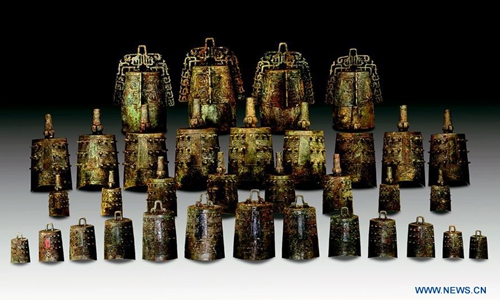ARTS / ART
Well-preserved 2,000-yr-old chime bells discovered in Henan

File photo shows bronze chime bells excavated from a tomb of the Spring and Autumn Period (770-476 BC) in Suizhou City, central China's Hubei Province. A total of six archaeological projects were made public by the Institute of Archaeology of the Chinese Academy of Social Sciences (CASS) on Friday as "China's 2019 archaeological discoveries of the year." The six laureate archaeological projects include a Neolithic site of Longshan Culture in east China's Shandong Province, a tomb of the Spring and Autumn Period (770-476 BC) in Hubei Province, and a tomb with frescos which dates back to Tibetan Tubo Kingdom (about 618-842) in the high-altitude Qinghai-Tibet Plateau. (Xinhua)
A total of 24 well-preserved bianzhong, or Chinese chime bells, have been discovered recently in Central China’s Henan Province. They date back to over 2,000 years ago during ancient China’s Spring and Autumn Period (770BC-476BC).
According to the Henan Provincial Institute of Cultural Heritage and Archaeology, the excavation site sits in the ruins of an ancient city of the Spring and Autumn Period near Zhengzhou, capital city of Henan. The bianzhong set was excavated in a sacrificial pit near the ruins of a palace.
“The bianzhong symbolize rank and power, and represent a high achievement in both the art and culture of ancient China,” Guan Ping, a Beijing-based historian, told the Global Times.
“The bianzhong were used at the kingdom palace as part of the ritual system. The discovery will help experts to examine cultural development in the Spring and Autumn Period and the Warring States Period,” Guan added.
Yu Jie, a staff member at the Henan Provincial Institute of Cultural Relics and Archaeology, said that the bianzhong sacrificial pit at the site is 2.6 meters long from east to west, 1.4 meters wide from north to south, and 0.8 meters deep.
“There are three rows of bell frames in the pit, with a total of 24 chime bells. The chime bells are well preserved, without any signs of looting, and the wooden frame is clearly visible,” Yu explained, adding that the frame can be “dated back to the middle and late Spring and Autumn Period”.
In addition, archaeologists also discovered two tombs near the palace ruins area. The tombs are in the shape of vertical pits, and complete bronze ritual vessels were unearthed.
Yu noted the tombs were probably for high-ranking people and this is the first time such tombs have been discovered in the ancient city. It is rare for discoveries to be so well preserved, Yu said, and this gives the find “important academic value.”
China’s bianzhong music originated over 3,000 years ago, and a set of bianzhong contains dozens of bronze bells with different shapes and scales, which are hung in a wooden frame and struck with a mallet to produce melodies.
“Music is strongly linked to rituals, and in ancient China, it played an important part in the ritual and music system to maintain social order,” Guan explained.
The Zhou Dynasty (1046BC- 256BC) was the first dynasty to lay down rules of rites and music, with sets of such instruments used in ceremonies, galas and performances. The different size of the bells, together with the different force the performer used to hit them, would create different tunes.
Bianzhong have been discovered in different parts of China in recent decades. In 1978, the discovery of bianzhong inside the tomb of the aristocrat Yi of Zeng in Suizhou, Central China’s Hubei Province, became world famous. The bells have a total 3,755 characters and are inlaid with gold.
The set was listed in the Order Prohibiting the Export of Valuable Cultural Relics of China in 2013. In 1981, another bianzhong set was discovered near Yi’s tomb.
The ancient city ruins where the recent discovery was made cover an area of 16 square kilometers. Listed as a National Archaeological Ruins Park in 2017, the area has been excavated, showing a clear structure of the city in the Spring and Autumn Period and the Warring States Period. It has provided precious materials for research in areas such as burial systems and defense systems.
